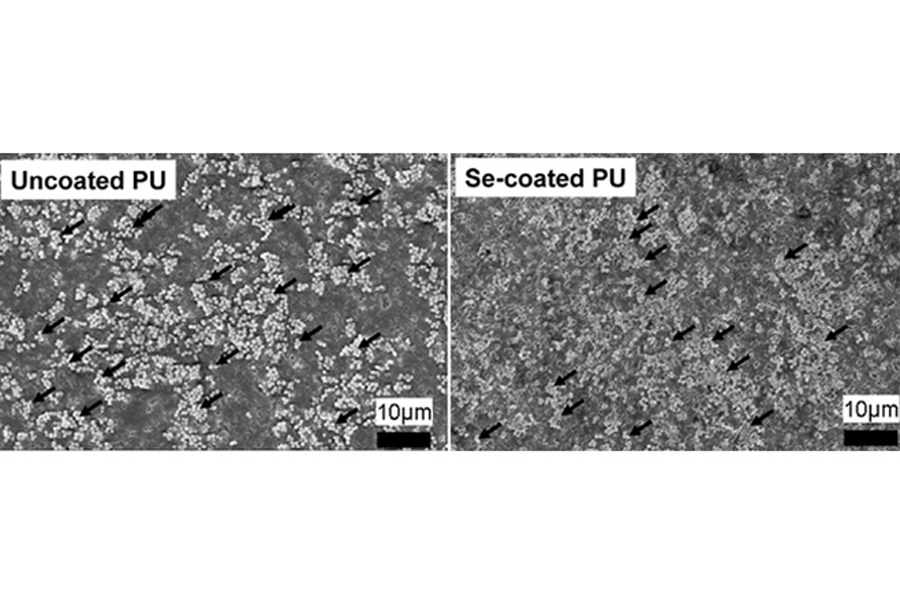To Keep Surfaces Bacteria-Free, Add Selenium

(ISNS) – There's a new way to prevent medical implants from causing infection: treat them with a naturally antimicrobial element called selenium before they ever enter the body.
The durable and flexible materials called polymers are nearly ideal for making medical devices such as catheters and breathing tubes, as well as implants to replace joints and support bones.
Unfortunately, bacteria love to grow on smooth polymer surfaces, creating a sticky biofilm that resists both antibiotics and the body's natural defenses.
To clear up the bacteria, patients often face further surgery to remove implants, as well as a regimen of antibiotics. But these drugs can fail as microbes mutate and develop resistance.
"It's a huge problem," said Thomas Webster, a chemical engineer at Northeastern University, in Boston, "which is why we like non-drug solutions — like selenium."
Our bodies naturally contain trace amounts of selenium: it's a component of several important enzymes. But although small quantities of this element are part of a healthy diet, in large amounts, it can be toxic. And on its own, it can kill both cancer cells and bacteria.
As Webster discovered, materials coated with tiny particles of selenium will resist bacterial colonization. In his most recent study, published in the journal Nanotechnology, he pitted selenium-coated polymers against the culprit behind staph infections: the bacteria Staphylococcus aureus.
Get the world’s most fascinating discoveries delivered straight to your inbox.
Researchers looked at three polymers commonly used in medical devices: polyvinyl chloride, or PVC, polyurethane, and silicone. First, they cut tiny disks — less than a tenth the volume of a single M&M candy — of each polymer. Then they soaked the disks in a solution that released selenium onto nearby surfaces.
About 25 percent of the disks' surfaces became coated with nanoparticles, small clusters on the scale of billionths of a meter. The PVC disks contained the highest concentration of selenium, followed by silicon, and then polyurethane. And after eight hours of exposure to Staphylococcus aureus, the selenium-treated disks hosted significantly fewer bacteria than uncoated disks. The more selenium that coated a polymer disk, the more effectively it repelled bacteria.
In addition to Staphylococcus, Webster found selenium can ward off several other strains of bacteria. And its abilities aren't limited to polymers: it can also protect metals, ceramics, and other materials from these microbes.
But despite selenium's success, it's a bit late to the party — scientists are already using silver and silver-based compounds to give devices microbial protection.
"You can use copper, zinc, silver, selenium — with metal ions in sufficient concentration, you kill the bacteria," said Krasimir Vasilev, who researches antibacterial treatments at the University of South Australia, in Adelaide. "I don't think selenium will have any advantages over silver."
Webster did find that selenium-coated PVC was more effective than commercial silver-coated PVC. But this was not a direct comparison.
"Comparison with silver is not appropriate because the silver has not been characterized," said Vasilev. He pointed out that for a direct comparison, you would have to ensure each polymer had equal amounts of each element, with nanoparticles of the same size.
Even if selenium doesn't outperform silver, Webster still prefers it for two reasons: Unlike silver, selenium occurs naturally in the body, and it's much cheaper.
"If you have a normal length catheter for an adult, it would cost 5 cents to coat it with selenium," he explained.
This would add very little to an untreated catheter's $2 price tag. In contrast, a silver-coated catheter costs $100.
Webster is currently researching rats' reactions to selenium-coated implants that have been exposed to bacteria. He needs to prove that selenium can quell infections in living animals, not just in a petri dish. If successful, he hopes to test similar implants in larger animals like sheep, and then seek FDA approval to use the equipment in humans.
If animal testing is successful, Webster expects his coated devices could become commercially available within five years. In addition to medical equipment, he thinks that selenium could create bacteria-free surfaces in locations like hospitals, where dangerous infections can spread easily.
"We've started coating almost anything you can think of with selenium. We've coated paper towels, we've coated doorknobs," said Webster. "With those selenium surfaces, you don't have to worry about bacteria ever being there in the first place."
Sophie Bushwick is a freelance science writer based in New York City. Her work has appeared in numerous print and online outlets.
Inside Science News Service is supported by the American Institute of Physics.


